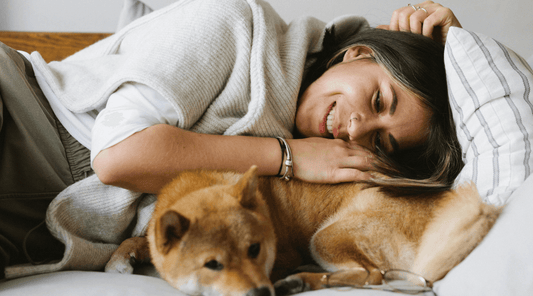
How to Stop Your Dog From Eating Too Fast: 8 Simple Solutions
Rachel RobsonShare
Is your furry friend inhaling their food like there's no tomorrow? Trust me, I get it!
As a dog parent, watching your pup gobble down their meal in seconds can be both amusing and concerning.
But here's the thing - speed eating isn't just a quirky habit; it can lead to some serious health issues for your four-legged family member.
Why Do Dogs Eat So Fast?
Before we dive into solutions, let's understand why your pup might be treating every meal like a competitive sport. Dogs often develop this habit due to:
- Competition with other pets during puppyhood, creating a "survival of the fastest" mentality that sticks around well into adulthood
- Past experiences of food scarcity, especially in rescue dogs who may have had to compete for limited resources
- Natural instincts from their wild ancestors, who needed to eat quickly to protect their food from other predators
The Risks of Speed Eating in Dogs
When your dog treats mealtime like a race against the clock, they're putting themselves at risk for several health issues:
- Choking hazards from not chewing properly
- Bloat (gastric dilatation-volvulus), a potentially life-threatening condition
- Digestive issues and discomfort
- Vomiting shortly after meals
- Poor nutrient absorption
8 Effective Solutions to Slow Down Your Dog's Eating
1. Invest in a Slow-Feeder Bowl
These specially designed bowls come with ridges, mazes, or patterns that make it physically impossible for your dog to gulp their food. They're like puzzle feeders that turn mealtime into a fun challenge! Look for one that matches your dog's size and eating style.
2. The DIY Tennis Ball Trick
Don't want to spend money on a new bowl? Place a clean tennis ball in your dog's regular food bowl. They'll have to eat around it, naturally slowing down their pace. Just make sure the ball is too big for them to swallow!
3. Spread Their Food on a Cookie Sheet
This budget-friendly solution forces your dog to "chase" their kibble around a larger surface area. It's simple but surprisingly effective at slowing down even the speediest eaters.
4. Try the Multiple Meals Approach
Instead of serving two large meals, divide their daily portion into 3-4 smaller meals. This helps prevent hunger-induced speed eating and maintains more stable blood sugar levels throughout the day.
5. Use Interactive Food Toys
Kong toys and treat-dispensing balls aren't just for fun - they're excellent tools for controlling your dog's eating speed. Fill them with kibble or wet food to make mealtime both entertaining and lengthy.
6. The Hand-Feeding Method
While time-consuming, hand-feeding can help establish better eating habits and strengthen your bond with your pet. It's especially useful for puppies or newly adopted dogs.
7. Add Water to Dry Food
Creating a soup-like consistency makes it physically impossible for your dog to inhale their food. Plus, the added moisture can aid digestion and help keep them hydrated.
8. Practice the "Wait" Command
Teaching your dog to wait for their food develops patience and self-control. Start by having them sit and wait for a few seconds before eating, gradually increasing the duration.
When to Consult Your Vet
While these solutions work for most dogs, sometimes rapid eating can signal underlying health issues. Contact your veterinarian if you notice:
- Sudden changes in eating behaviour
- Excessive hunger despite regular feeding
- Weight loss despite normal food intake
- Persistent vomiting after meals
The Bottom Line
Remember, changing your dog's eating habits takes time and patience. Try different methods to find what works best for your pup, and be consistent with your chosen approach. Your dog might not thank you immediately for slowing down their meals, but their improved digestion and overall health will be worth the effort!
Have you tried any of these methods with your speed-eating pup? Start with one solution and gradually introduce others if needed. Your dog's health is worth the extra effort, and with these tips, you're well on your way to creating healthier eating habits for your furry friend.
[Editor's Note: Always monitor your dog with new feeding methods and consult with your veterinarian before making significant changes to their feeding routine.]



